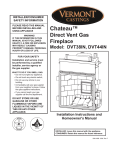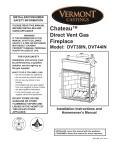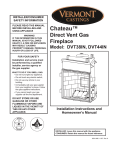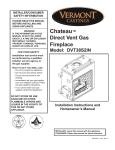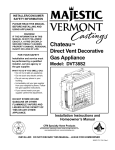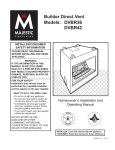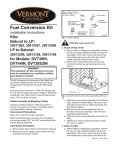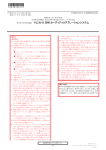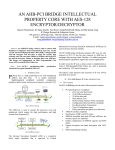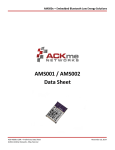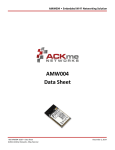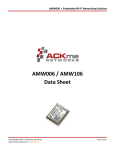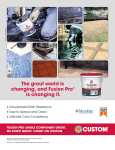Download Vermont Casting DVT38S2IN User's Manual
Transcript
INSTALLER/CONSUMER SAFETY INFORMATION PLEASE READ THIS MANUAL BEFORE INSTALLING AND USING APPLIANCE WARNING! IF THE INFORMATION IN THIS MANUAL IS NOT FOLLOWED EXACTLY, A FIRE OR EXPLOSION MAY RESULT CAUSING PROPERTY DAMAGE, PERSONAL INJURY OR LOSS OF LIFE. FOR YOUR SAFETY Installation and service must be performed by a qualified installer, service agency or the gas supplier. Chateau™ Direct Vent Gas Fireplace Model: DVT38S2IN WHAT TO DO IF YOU SMELL GAS: • Do not try to light any appliance. • Do not touch any electric switch; • Do not use any phone in your building. • Immediately call your gas supplier from your neighbor’s phone. Follow the gas suppliers instructions. • If you cannot reach your gas supplier call the fire department. DO NOT STORE OR USE GASOLINE OR OTHER FLAMMABLE VAPORS AND LIQUIDS IN THE VICINITY OF THIS OR ANY OTHER APPLIANCE. Installation Instructions and ����� Homeowner’s Manual ������������� ���� � � � � � �� �� �������� � � �� � � � � � INSTALLER: Leave this manual with the appliance. CONSUMER: Retain this manual for future reference. 20011957 9/07 Rev. 1 Chateau™ Direct Vent Gas Fireplace Table of Contents Please read the installation & operating instructions before using this appliance. Thank you and congratulations on your purchase of a CFM Corporation fireplace. IMPORTANT: Read all instructions and warnings carefully before starting installation. Failure to follow these instructions may result in a possible fire hazard and will void the warranty. Installation & Operating Instructions Important Curing/Burning Instructions .................................................................................................3 Fireplace Dimensions ..........................................................................................................................4 Locating Your Fireplace .......................................................................................................................5 Clearance to Combustibles .................................................................................................................5 Mantels .............................................................................................................................................5 Hearth .............................................................................................................................................6 Framing & Finishing.............................................................................................................................6 Final Finishing .....................................................................................................................................6 Gas Specifications ...............................................................................................................................6 Gas Inlet and Manifold Pressures .......................................................................................................7 High Elevations....................................................................................................................................7 Gas Line Installation ............................................................................................................................7 Electrical Junction Box ........................................................................................................................7 Control System ....................................................................................................................................8 Control System Installation ..................................................................................................................8 Special Features for Cold Climates .....................................................................................................9 Remote Control Transmitter Operating Instructions ..........................................................................10 General Venting Information General Venting .................................................................................................................................14 General Venting Information - Termination Location .........................................................................15 General Information Assembling Vent Pipes .....................................................................................16 SK8 Venting Pipes .............................................................................................................................16 Restrictor Plate Guide .......................................................................................................................17 Horizontal Termination .......................................................................................................................18 Vertical Termination ...........................................................................................................................18 Sidewall Applications & Installation ...................................................................................................18 Sidewall Installation with Stationary Glass Facing Outside ...............................................................20 Installing the 38S2VDK Door .............................................................................................................21 Vertical Through-the-Roof Applications & Installation ........................................................................22 Use of Restrictor Plates for Vertical Venting Application ...................................................................22 Flue Restrictor Plate Installation ........................................................................................................22 Chimney Components .......................................................................................................................26 Operating Instructions Glass Information ..............................................................................................................................27 Glass Frame Assembly Removal ......................................................................................................27 Glass Cleaning ..................................................................................................................................27 Ceramic Refractory Installation .........................................................................................................27 Log, Lava Rock and Ember Placement .............................................................................................28 Flame Characteristics ........................................................................................................................32 Trim Installation .................................................................................................................................33 Lighting and Operating Instructions (American Flame Automatic Control System) ...........................34 Troubleshooting .................................................................................................................................35 American Flame Gas Control System Error Codes ...........................................................................37 Fuel Conversion ................................................................................................................................38 Maintenance Cleaning the Control System .............................................................................................................41 Replacement Parts .......................................................................................................................................42 Optional Accessories ...................................................................................................................................45 Warranty .........................................................................................................................................................47 Energuide ......................................................................................................................................................48 2 20011957 Chateau™ Direct Vent Gas Fireplace Installation & Operating Instructions This gas fireplace should be installed by a qualified installer, preferably NFI or WETT (Canada) certified, in accordance with local building codes and with current CSAB149.1 Installation codes for Gas Burning Appliances and Equipment. For USA Installations follow local codes and/or the current National Fuel Gas Code. ANSI Z223.1/NFPA 54. In the Commonwealth of Massachusetts: • All gas fitting and installation of this heater shall only be done by a licensed gas fitter or licensed plumber. • A carbon monoxide detector must be installed in the same room as the fireplace. (Refer to Regulation 248CMR 4.00 & 5.00 for more information.) FOR SAFE INSTALLATION AND OPERATION PLEASE NOTE THE FOLLOWING: 1. This fireplace gives off high temperatures and should be located out of high traffic areas and away from furniture and draperies. 2. Children and adults should be alerted to the hazards of the high surface temperatures of this fireplace and should stay away to avoid burns or ignition of clothing. 3. CAUTION: Due to high glass surface temperature children should be carefully supervised when in the same room as fireplace. � ������� �������������� ������������ ������������������ ������������� �������������������� ��������������� 4. Under no circumstances should this fireplace be modified. Parts removed for servicing should be replaced prior to operating this fireplace again. 5. A professional service person should be contacted to inspect the fireplace annually. More frequent cleaning may be required due to excess lint and dust from carpeting, bedding material, etc. 6. Control compartments, burners and air passages in this fireplace should be kept clean and free of dust and lint. Make sure that the gas valve and pilot light are turned off before you attempt to clean this fireplace. 7. The venting system (chimney) of this fireplace should be checked at least once a year and if needed your venting system should be cleaned. 8. Keep the area around your fireplace clear of combustible materials, gasoline and other flammable vapor and liquids. This fireplace should not be used as a drying rack for clothing, nor should Christmas stockings or decorations be hung on or around the fireplace. 9. Under no circumstances should any solid fuels (wood, coal, paper or cardboard etc.) be used in this fireplace. 10. The flow of combustion and ventilation air must not be obstructed in any way. 11. When the fireplace is installed directly on carpeting, vinyl tile or any combustible material other than wood, 20011957 this fireplace must be installed on a metal or wood panel extending the full width and depth of the fireplace. 12. This fireplace requires adequate ventilation and combustion air to operate properly. 13. This fireplace must not be connected to a chimney flue serving a separate solid fuel burning fireplace. 14. When the fireplace is not in use it is recommended that the gas control valve be left in the “OFF” position. NOTE: We recommend that you install the Battery Back-up Kit, DVTBBK, which must be installed at the time of fireplace installation. The use of this kit will allow your fireplace to continue to operate in the event electric power is lost such as during a severe snow, ice or thunder storm. Refer to Item 16 on Page 8. DVT38S2 Certified To ANSI Z21.50b-2005 / CSA 2.22b-2005 Vented Gas Fireplace WARNING: Check with your electronics manufacturer before installing a television or other electronic device above this fireplace. IMPORTANT: PLEASE REVIEW THE FOLLOWING CAREFULLY Remove any plastic from parts before turning the fireplace ON. It is normal for fireplaces fabricated of steel to give off some expansion and/or contraction noises during the start up or cool down cycle. Similar noises are found with your furnace heat exchanger or car engine. It is not unusual for your gas fireplace to give off some odor the first time it is burned. This is due to the curing of the paint and any undetected oil from the manufacturing process. Please ensure that your room is well ventilatedopen all windows. It is recommended that you burn your fireplace for at least ten (10) hours the first time you use it. This appliance may be installed in an aftermarket permanently located, manufactured home or mobile home, where not prohibited by local codes. This appliance is only for use with the type of gas indicated on the rating plate. This appliance is not convertible for use with other gases, unless a certified kit is used. The DVT38S2 has been approved for mobile home installations. Proposition 65 Warning: Fuels used in gas, woodburning or oil fired appliances, and the products of combustion of such fuels, contain chemicals known to the State of California to cause cancer, birth defects and other reproductive harm. California Health & Safety Code Sec. 25249.6 3 Chateau™ Direct Vent Gas Fireplace Fireplace Dimensions Finished Wall 24¹⁄₂” (622 mm) for Flush Install 16” (406 mm) I.D. Minimum Clearance to Combustibles 25����” (649 mm) Standard Framing Exterior Side (If installed on outside wall) C L 3/4" (19 mm) 24���" (622 mm) C L 10���" (267 mm) 51���" (1299 mm)* Only Noncombustible Material in This Area 3/4" (19 mm) C L Glass 25����” (649 mm) 49���" (1245 mm) Sides and Top of Surround Interior Side 34���" (876mm) Gas Line Connection NOTE: Noncombustible insulation may be placed behind the facing material. 33���" 29���" (854 mm)* (746 mm) 32���" (829 mm) 15���” (403 mm) 10����” (262 mm) 1/2" (13 mm) 1���" (35 mm) 5/8" (16 mm) 5���" (143 mm) 37���" (962 mm) 6" (152 mm) 44���" (1121 mm) 1" (25 mm) * When framing unit on outside wall, flush with the wall, Noncombustible Material in This Area a 1/4" (6mm) clearance must be allowed on both sides and top of surround. Fig. 1 Fireplace specifications and framing dimensions for DVT38S2. 11957 DVT38s2 specs 5/07 Locating Your Fireplace Y D A) Flat on wall D) *Flat on wall corner Y) 6” minimum A B Y B) **Island C) *Room divider E) Chase installation Note (Fig. 2): ** Island (B) and Room Divider (C) installation is possible as long as the horizontal portion of the vent system (X) does not exceed 20’ (610cm). See details in Venting Section. * When you install your fireplace in (C) Room divider or (D) Flat on wall corner positions (Y), a minimum of 6” (152mm) clearance must be maintained from the perpendicular wall and the front side edge of the fireplace. X C E LU584-1 Fig. 2 Locate gas fireplace. 4 LU584 Locating unit DVT38S2 3/17/04 djt 20011957 Chateau™ Direct Vent Gas Fireplace Combustible Framing and Finish Wall Above Standoffs May use combustible facing material in this area Standoff Clearance to Combustibles Top of Unit to Ceiling ................................ 36” (914 mm) Front of Unit to Combustibles (both sides) 36” (914 mm) Appliance Top Standoffs .............................................. 0” (0 mm) Bottom* ....................................................... 0” (0 mm) Side Standoffs ............................................. 0” (0 mm) Back Standoffs ............................................ 0” (0 mm) Venting Horizontal Termination through-a-side wall: Vertical Sections: Sides ................................................ 2¹⁄₂” (64 mm) Horizontal Sections: Top .................................................. 3¹⁄₂” (89 mm) Bottom ............................................. 1¹⁄₂” (38 mm) Sides ................................................ 2¹⁄₂” (64 mm) Vertical Vent Application: Sides ............................................... 1¹⁄₂” (38 mm) * To prevent the potential for odors, do not use epoxyfilled particle board directly under this fireplace. Mantels The height that a combustible mantel is fitted above the fireplace is dependent on the depth of the mantel. This also applies to the distance between the mantel leg (if fitted) and the fireplace. For the correct mounting height and widths refer to Figs. 3a and 3b, the following Mantel Charts. Noncombustible mantels and legs may be installed at any height and width around the appliance. When using paint or lacquer to finish the mantel, such paint or lacquer must be heat resistant to prevent discoloration. � � � � � � � � � � Noncombustible Finish Material (Such as Dura Rock) Fireplace Front CFM146d Top of Sheet Metal Mantel Chart Mantel Shelf Mantel from Top Ref. or Breast Plate Ref. of Comb. Chamber Depth V 10” (254 mm) A 10” (254 mm) W 9” (229 mm) B 9” (229 mm) X 8” (203 mm) C 8” (203 mm) Y 7” (178 mm) D 7” (178 mm) Z 6” (152 mm) E 6” (152 mm) Fig. 3a Combustible mantel minimum installation. ������� ������� ������������ � � Mantel Leg � � � CFM164c Side of Fireplace � � � � � ������� ��������������� ������� ������������� Noncombustible Finish Material CFM170a 20011957 Mantel Mantel Leg from Side Ref. Leg Depth Ref. of Comb. Opening F 12” (305 mm) K 12” (305 mm) ������ ����������������� G 9” (229 mm) L 9” (229 mm) ���� H 6” (152 mm) M 6” (152 mm) ������������� I 4” (102 mm) N 4” (102 mm) J 3” (76 mm) O 3” (76 mm) Fig. 3b Combustible mantel leg minimum installation. 5 Chateau™ Direct Vent Gas Fireplace Hearth A hearth is not mandatory but is recommended for aesthetic purposes. We recommend a noncombustible hearth which projects out 12” (305 mm) or more from the front of the fireplace. The hearth cannot exceed 1¹⁄₂” (38 mm) in height from bottom of fireplace for ease of door accessibility. (Fig. 4) Cold climate installation recommendation: When installing this unit against a noninsulated exterior wall or chase, it is mandatory the outer walls be insulated to conform to applicable insulation codes. 1" (25 mm) Framing and Finishing 1. Choose the unit location. 2. The unit is shipped with four (4) nailing flanges mounted near the front corners on the side with the valve box assembly . (Fig. 4) 3. Frame the fireplace with a header across the top of the standoff. (Fig. 5) It is very important to allow for the finished wall face along with marble, tiles or any other noncombustible face finish material desired when setting the depth of the framing. 4. Attach the fireplace nailing flanges to the frame as shown in Figure 4. Bend Line 6" (152 mm) Min. 1" (25 mm) Min. 6" (152 mm) This side of fireplace must be facing interior of home FP1467b Fig. 5 Fireplace framing. FP1467b DVT38s2 are positioned 1” (25mm) back from the face of the framing unit. NOTE: The U-channel 5/07 djtdepth can be adjusted by loosening the hex nut inside the channel. If marble, tile or any other noncombustible decorative face finish material is desired, a 3” (76mm) wide noncombustible board (recommended Dura-Rock) is to be nailed to the nailing flanges on both sides of the unit. Also, 12” (305mm) of noncombustible board is to be nailed to the front face of the U-channel and the top framing member above the standoff. Combustible material can then be brought to the outside edges of the noncombustible board installed earlier. Any noncombustible decorative face finish could be brought to the sides and top of the unit and can cover the framing and sheet rock. If a decorative facing is not desired, then the noncombustible boards must be double thickness and brought flush with the face of the unit. Final Finishing Noncombustible materials such as brick or tile may be brought to the edges of the face of the appliance. 1���" (38mm) Max. Hearth Height Gas Specifications FP1357c FP1357b DVT38s2nailing flanges 5. The gas components are located 3/17/04 indjtthe valve box asFig. 4 Nailing flanges. sembly attached to the side of the unit. 6. The U-channel located on the top of the unit as well as the nailing flanges on the sides that were mentioned in Step 1, are designed to accommodate noncombustible board (recommended Dura-Rock). They 6 Gas Model Fuel Control DVT38S2IN Natural Gas AF-4034 w/ DVT38S2IP Propane 7.5 DC Hi/Lo Max. Input BTU/h 56,000 56,000 Min. Input BTU/h 38,000 45,500 20011957 Chateau™ Direct Vent Gas Fireplace Gas Inlet and Manifold Pressures Minimum Inlet Pressure Maximum Inlet Pressure Manifold Pressure 1/2” NPT X 1/2” Flare Shut-off Valve Natural LP (Propane) 5.5” w.c. 11.0” w.c. 14.0” w.c. 14.0” w.c. 3.5” w.c. 10.0” w.c. High Elevations Input ratings are shown in BTU per hour and are certified without deration for elevations up to 4,500 feet (1,370m) above sea level. For elevations above 4,500 feet (1,370m) in USA, installations must be in accordance with the current ANSI Z223.1/NFPA 54 and/or local codes having jurisdiction. In Canada, please consult provincial and/or local authorities having jurisdiction for installations at elevations above 4,500 feet (1,370m). WARNING: Improper installation, adjustment, alteration, service or maintenance can cause injury or property damage. Refer to this manual for correct installation and operational procedures. For assistance or additional information consult a qualified installer, service agency, or the gas supplier. Gas Line Installation When purging gas line the front glass must be removed. A gas shut off valve must be installed on the gas pipe line going into the appliance within easy access. The gas pipeline can be brought in through the top of the valve box assembly. The gas line connection can be made with properly tinned 1/2” copper tubing or 1/2” gas tight. Some municipalities have additional local codes, it is always best to consult your local authority and the CSA-B149.1 installation codes. For USA installations consult the current National Fuel Gas Code, ANSI Z223.1/NFPA 54. 20011957 FP297A 1/2” Gas Supply 1/2” Gas Tight or Tinned Copper (from valve) (Not provided) Fig. 6 Typical gas supply installation. Always check for gas leaks with a mild soap and water������ solution applied with a brush no larger��������������� than 1” (25mm). Never ap������������������ ply soap and water solution with a spray ������ bottle. Do not use an open flame for leak testing. The fireplace valve must not be subjected to any test pressures exceeding 1/2 psi. Isolate or disconnect this or any other gas appliance control from the gas line when pressure testing. The gas control is equipped with an inlet and manifold pressure test point, therefore it is not necessary to provide an 1/8” test point up stream of the control. When using copper, use only approved fittings. Always provide a union when using black iron pipe so the gas line can be easily disconnected for burner servicing. A union may not be behind a wall. (Fig. 8) See the gas specifications for pressure details and ratings. Electrical Junction Box The fireplace, when installed, must be electrically connected and grounded in accordance with local codes or, in the absence of local codes, with the current CSA C22.1 Canadian Electrical Code or the national electrical code ANSI/NFPA No. 70 in the USA. It is strongly suggested that the wiring of the Electrical Junction Box be carried out by a licensed electrician. The box should be near the valve box assembly to plug the cord into. Ensure the power to the supply line has been disconnected before commencing this procedure. 7 Chateau™ Direct Vent Gas Fireplace Control System The gas control system is located on the right hand side of the firebox behind an access panel and the decorative brick panel. The fireplace is operated using only the hand held remote control unit. The system wiring diagram is shown in Figure 11. NOTE: If you choose to install the battery back-up, Model DVTBBK, refer to Item #16 in the next section. Gas Supply Fitting Pressure Test Ports Learn Button Control System Installation 1. Locate the fireplace in the desired location. 2. Remove the glass. Refer to Glass Frame Assembly Removal section. 3. If installed, remove the lava rock, volcanic rock, andirons, embers and logs, making note of each log’s location. 4. If installed, remove the refractory brick panel on gas supply side. 5. Using a back-up wrench, disconnect the gas supply fitting. (Fig. 7) Cover Plate Gas Supply Fitting FP1801 Fig. 7 Disconnect gas supply fitting and remove 13 screws securing the cover plate. 6. Remove pilot assembly from burner assembly by removing two (2) screws. ������ 7. Carefully slide the burner assembly out of the way, ����������� taking care not to bend or break the pilot tubes or wiring. ���� 8. Remove 13 screws around the perimeter holding large access panel on the side of the firebox. 9. Carefully pull back the panel just enough to gain access to control box. 10. Connect the gas supply to the valve. (Fig. 8) Be sure to use a back-up wrench when tightening supply fitting. 8 FP1802 Fig. 8 Connect gas supply to valve. 11. Connect a 120V AC electrical supply to the junction box duplex outlet. Use a Romex-type strain relief connector when running wires out through the box knockout. Replace the duplex outlet and cover plate. 12. Plug the AC adaptor plug into the duplex outlet. 13. This control system must now be programmed to the hand held remote control transmitter. To program the remote control, make sure the 120V AC is connected and powered to the fireplace. ������ 14. Remove the battery door on the back of the hand ������������������ held remote control and install two (2) supplied “AAA” batteries. Be sure to note correct polarity. ���� Replace battery door. 15. Locate the learn button on the main module. (Fig. 9) Press and release the learn button using a pencil point. There will be a beep sound from the module. Then press any key on the remote control transmitter. Once the module’s internal receiver accepts the transmitter code, there will be a series of confirming beeps. 16. If you chose to install the optional back-up battery pack (No. DVTBBK), you must install a wall box from 3’ (914 mm) to within 15 feet (4.6 m) of the fireplace. Assemble the connectors on one end of the supplied extension wire harness to the mating connectors on wire harness within the control box. Make sure to connect black coded wire to black and red coded wire to red. 17. The other end of the extension wire harness should be connected to the wiring of the back-up battery holder located within a wall box. 18. Insert the supplied four (4) “AA” batteries into the battery older. Be sure to note correct polarity for each battery. 20011957 Chateau™ Direct Vent Gas Fireplace White or Green Green or White White or Orange Orange or White To Pilot Ignitor Pilot Main Main Module AF-4000 Black Red Learn Button Power Module Orange Red Brown Black S DC Motor I To Pilot Flame Sensor Remote Battery Back-Up Pack Remote/Off Switch Continuous Pilot ON/OFF Switch Black Gnd Brown (SWI) (Optional Brown (SWI) ON/OFF Switch) Red Black AC Adaptor FP1795 Red Black Pulse/Continuous Button Extension Harness Fig. 9 DVT38S2 wiring diagram. 19. Mount electrical wall box containing back-up batFP1795 teries at a convenient location from 3’ (914 mm) to Chateau wiring diagram 15’ (4.6 m) of the fireplace. Cover wall box 3/07 using a blank wall plate. 20. The fireplace remote system is ready for use. 21. Reassemble access panel, burner assembly, gas supply connector, brick panels, logs, embers, andirons and lava rock in reverse order of removal. (Refer to Log, Lava Rock and Ember Placement section. 22. Turn on gas supply and check that all connections are tight and leak free. NOTE: If you need to test the inlet pressure and/or manifold pressure, there are two (2) test ports available along the front edge between the firebox side and outer casing. The upper test port is inlet pressure. The lower test port is manifold pressure. (Refer to Figure 8) CAUTION: Turn off the gas supply before removing test port plug. CAUTION: Turn off the fireplace and gas supply before removing test port adaptor and replacing plug. 27. After test, remove extension adaptor and replace plug securely. 28. Turn on gas supply and check that plugs are tight and leak free. Special Feature for Cold Climates This gas control system has the option of a continuous pilot feature. This allows the user to change from a spark to pilot system to a standing pilot system for direct vent appliances during cold climate conditions to keep the firebox warm. When the continuous pilot mode is activated and the fireplace is turned ON, the pilot will spark and light. When the fireplace is turned OFF, the pilot will stay ON when the main burner shuts OFF. The continuous pilot mode can be activated or de-activated by the hand held remote control transmitter. 23. Using a 7/16” nut driver, remove the threaded plug from the test port. 24. Thread the supplied extension adaptor into the open test port. 25. Attach a 1/4” diameter pressure gauge flexible hose fully onto the barb of the adaptor. 26. Turn on gas supply and operate valve with remote control as needed to indicate gas pressure. 20011957 9 Chateau™ Direct Vent Gas Fireplace Remote Control Transmitter Operating Instructions Introduction This transmitter operating range is approximately 20 feet (6 m). The transmitter operates on one of 1,048,576 security codes that are programmed into the transmitter at the factory; this transmitter operates on radio frequencies with nonTransmitter Wall Clip Slot Off Continuous Pilot Button Mode Button The transmitter operates on (2) 1.5V AAA batteries. It is recommended that ALKALINE batteries always be used for longer battery life and maximum operational performance. �� On H/L Button ON H/L Before using the transmitter, install the (2) AAA transmitter batteries into the battery compartment. (Use caution that batteries are installed in the proper direction.) OFF/CONTINUOUS PILOT BUTTON MODE SET Set Button Battery Compartment FP1818 ON H/L 1 FP1818 Skytech remote 9/07 Key Settings 1. ON H/L OFF Continuous Pilot 2 MODE 3 2. OFF CONTINUOUS PILOT 3. MODE 4. SET SET — Turns unit to ON and operates the flame control HI or LO. 4 — Shuts the unit OFF and activates the continuous pilot on feature. — Changes unit from manual mode to thermostatic mode. — Sets temperature in thermo mode. LCD - Liquid Crystal Display 7 2 ����� 1 4 3 ���� ��� ���� 5 1. 2. 3. 4. 5. 6. DISPLAY ° F or ° C FLAME ROOM TEMP SET 7. PILOT Indicates CURRENT room temperature. Indicates degrees Fahrenheit or Celsius Indicates burner/valve in operation Indicates remote is in THERMOSTATIC mode Appears during manual operation Appears while setting the desired temperature in the thermostatic mode Appears in the Continuous Pilot mode 6 20011957 10 FP1819 LCD display 9/07 Chateau™ Direct Vent Gas Fireplace Setting ° F / ° C Scale ����� ���� The factory setting for temperature is ° F. To change this setting to ° C; Press the ON H/L key and the OFF CONTINUOUS PILOT key on the transmitter at the same time. This will change from ° F to ° C. Follow this same procedure to change from ° C to ° F. ��� Manual Function To operate the system in the manual “MODE” do the following: ���� Screen while depressing ON key Screen after 3 second default ON - HI Flame Operation Press and release the ON H/L key. The appliance flame will come ON and display will s
















































